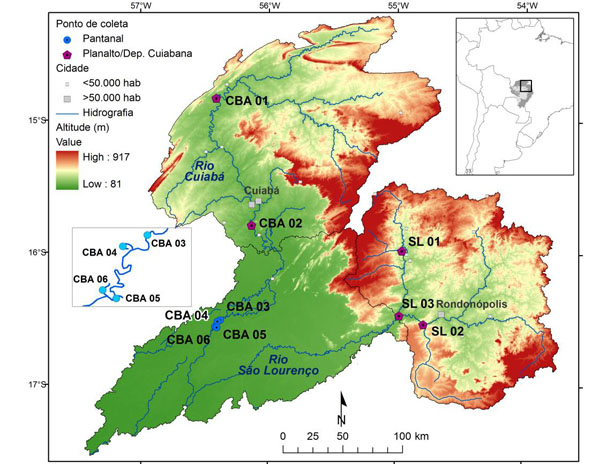Resíduos de pesticidas em sedimento de fundo de rio na Bacia Hidrográfica do Rio Cuiabá, Mato Grosso, Brasil
Palabras clave:
contaminação, escoamento superficial, recursos hídricos
Resumen
O rio Cuiabá é um importante tributário do rio Paraguai, cuja bacia é de grande importância por agasalhar o Pantanal, a maior área úmida do planeta. A base econômica da bacia hidrográfica do rio Cuiabá é a produção agrícola e pecuária que, para manter elevada produtividade, requer grandes quantidades de insumos agrícolas como os pesticidas que, podem atingir diversos ambientes devido aos processos de dispersão que ocorrem após sua introdução no ambiente. Os sedimentos desempenham importante papel para a caracterização da poluição de rios devido a seu potencial de acumulação de poluentes. Este estudo objetivou avaliar a contaminação por pesticidas usados nas lavouras plantadas na bacia do rio Cuiabá, MT. Para tanto, amostras de sedimento de fundo foram coletadas mensalmente de agosto de 2011 a julho de 2012. Para a determinação dos pesticidas atrazina, cipermetrina, clorpirifós, endossulfam (α, β e seu metabólito endossulfam sulfato), lambda-cialotrina, malationa, metolacloro, metribuzim, parationa metílica, permetrina e trifuralina no sedimento utilizou-se método multirresíduo que consiste na extração sólido-líquido por agitação mecânica seguida de purificação por extração líquido-líquido e identificação e quantificação por cromatografia a gás acoplada a espectrometria de massas. Resíduos de pesticidas foram identificados em amostras coletadas em agosto e setembro de 2011 e janeiro, fevereiro, abril e julho de 2012, em concentrações variando de 5,7 a 79,3 µg kg-1. Embora a frequência de detecção tenha sido baixa, esses resultados indicam que há potencial de transporte de pesticidas usados na bacia do rio Cuiabá e seus tributários atingindo o Pantanal.
Publicado
21/03/2014
Número
Sección
Articulos
Authors maintain the copyrights for their work. However, they grant rights of first publication to Ambiente e Agua - An Interdisciplinary Journal of Applied Science. In compensation, the journal can transfer the copyrights, allowing non-commercial use of the article including the right of sending the article to other data bases or publication media. La revista utiliza la licencia CC BY 4.0"






